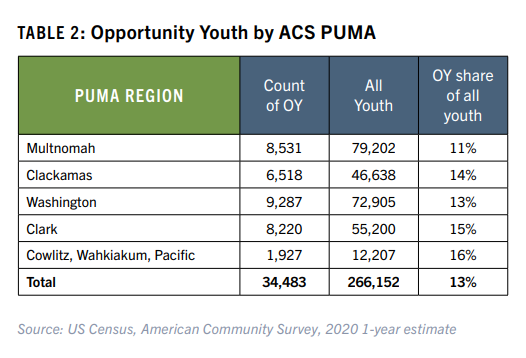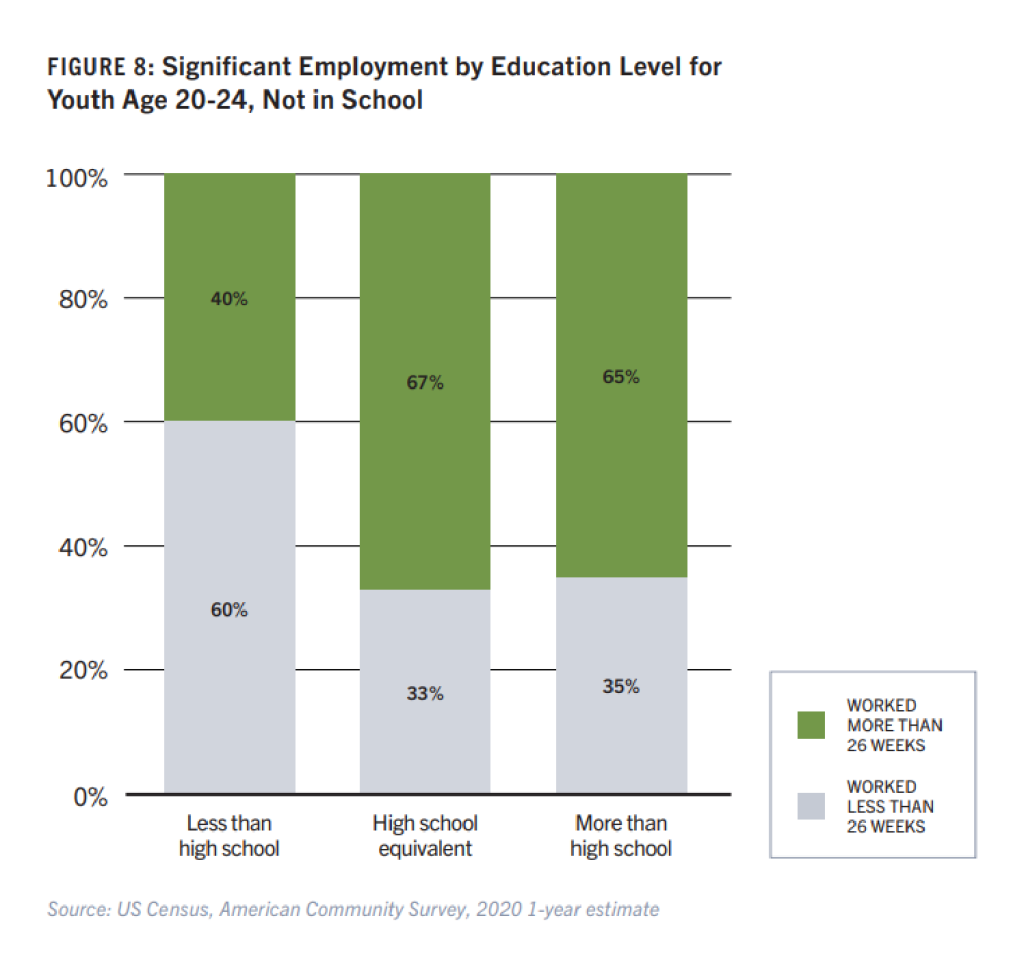The 2022 Opportunity Youth Report, from Workforce Southwest Washington (WSW) and its Columbia-Willamette Workforce Collaborative (CWWC) partners, found that an estimated 34,400 16-to-24-year-olds in the Portland-Southwest Washington region are not in school or working. This accounts for more than 13% of all youth in the region.
 Opportunity youth are defined as individuals between the ages of 16 to 24, who are not working and are not enrolled in school in the six-county area (Clackamas, Clark, Cowlitz, Multnomah, Wahkiakum and Washington).
Opportunity youth are defined as individuals between the ages of 16 to 24, who are not working and are not enrolled in school in the six-county area (Clackamas, Clark, Cowlitz, Multnomah, Wahkiakum and Washington).
As of 2020, there were 10,147 opportunity youth in Southwest Washington. Of those, 8,220 resided in Clark County and 1,927 resided in Cowlitz, Wahkiakum and Pacific counties. The number of opportunity youth is up slightly since the 2018 Opportunity Youth Report, which reported 10,039 opportunity youth in Southwest Washington. Since then, while the number of opportunity youth has decreased from 2,861 in Cowlitz, Wahkiakum and Pacific counties, Clark County has seen an increase up from 7,178. According to the report, opportunity youth come from complex, intersectional backgrounds, with 34% of opportunity youth living below 200% of federal poverty level, 36% of youth are people of color and 14% of female opportunity youth lived with their own children.
According to a recent survey by McKinsey, a large number of youth, referred to in the report as Generation Z, do not see positive prospects for their financial future. Almost a quarter of Gen Z respondents do not expect to retire, and only 41% expect to own a home one day.
Gen Z also reports they are less financially secure. Forty-five percent of Gen Z are concerned about the stability of their employment, compared with 40% of all respondents. Gen Z is also more likely to report the pay they receive does not allow for a good quality of life.
These troubling prospects for Gen Z compound when, according to the 2022 Opportunity Youth Report, for each year an opportunity youth remains out of the labor force, future earnings become reduced by 2% to 3%. Consequently, past the age of 25, opportunity youth often face higher rates of adult unemployment and poverty throughout their lives.
“Programs that provide career and educational opportunities to our region’s young adults help to mitigate long-term financial effects by providing youth with the tools, support, services and work experience to continue on to post-secondary education or training and to obtain quality employment,” said Miriam Halliday, CEO of Workforce Southwest Washington, the local workforce development board for the counties of Clark, Cowlitz and Wahkiakum in Washington state.
The COVID-19 pandemic exacerbated the challenges youth faced. They were one of the hardest-hit groups when it came to job losses and unemployment. The official unemployment rate is likely an undercount of youth who lost their jobs.
 During the pandemic, enrollment at colleges and universities across Washington decreased. Community colleges were hardest hit, with enrollment declining 19% in Washington state from fall 2019 to fall 2020. In Southwest Washington, enrollment in community colleges decreased significantly. Between fall 2019 and fall 2020, enrollments at Lower Columbia College decreased 18%. At Clark College, enrollments decreased 17%. At Washington State University Vancouver, enrollments fell by 2.3%.
During the pandemic, enrollment at colleges and universities across Washington decreased. Community colleges were hardest hit, with enrollment declining 19% in Washington state from fall 2019 to fall 2020. In Southwest Washington, enrollment in community colleges decreased significantly. Between fall 2019 and fall 2020, enrollments at Lower Columbia College decreased 18%. At Clark College, enrollments decreased 17%. At Washington State University Vancouver, enrollments fell by 2.3%.
Figure 8 of the report demonstrates the importance of education to future employment. For youth aged 20-24, a majority of those with less than a high school diploma worked fewer than 26 weeks in 2016. Forty-seven percent had no reported employment during 2020. On the other end of the spectrum, 65% of those with some form of post-secondary education had employment for at least half of 2020.
As the workforce of the future, education and training of young adults is vitally important. WSW invests in and partners with organizations to support youth through career planning, work experience, education and quality job placement.
Next is a career and employment center for young adults ages 16-24 looking to gain education or career opportunities, founded by Workforce Southwest Washington, Educational Service District 112, Partners in Careers, Goodwill of the Olympic Rainier Region, Equus Workforce Solutions, and Job Corps.
Next partners offer a diverse set of services to help young adults achieve their career and educational goals while receiving holistic supports. Services include:
- One-stop connection to open jobs and companies that are hiring
- High school equivalency preparation and testing
- Essential skills development (such as time management and communications)
- Assistance getting industry-recognized credentials
- 1-on-1 case management with a Talent Development Specialist
- Support job searching
- Work experiences and paid internships
- Resume writing assistance and training
- Warm hand-offs to Clark College, WSU Vancouver and Lower Columbia College, as well as FAFSA completion
- Practice interviews
- Providing workshops and classes to help prepare for the job
- Funding support for job training to help young adults get in-demand jobs
- Online training
- Financial literacy
In Cowlitz and Wahkiakum counties, WSW and Next partner with Goodwill of the Olympic and Rainier Region. This partnership provides Next’s services at the Goodwill Work Opportunity Center in Longview, WA.
“The services at Goodwill are helping our young adults get education and skills that can help them gain employment while at the same time giving local businesses a resource to fill jobs. It’s a great program that meets the training needs of individuals and the economic needs of local businesses,” said Bill Marcum, CEO of the Kelso-Longview Chamber of Commerce.
By working with Goodwill, WSW and Next reach a larger audience of opportunity youth and leverage Goodwill’s strong community connections to provide services integral for young adults’ career and educational development.
In addition to the services provided through Next, WSW also invests in internship programs and work-based learning initiatives to help young adults gain experience integral to their success. WSW facilitates two internship programs, Future Leaders Project and SummerWorks.
The Future Leaders Project, in partnership with the Columbia River Economic Development Council and Washington State University Vancouver, provides summer internships to WSU Vancouver students who are from historically underserved populations and/or first-generation college students.
The SummerWorks program at Next provides 100-hour paid internships and work-readiness training to youth. Between 2018 and 2021, 300 opportunity youth and also youth in their junior and senior years of high school participated in the SummerWorks program.
“As WSW continues to enhance its emphasis on equitable investments that address systemic racism and social determinants of employment, prioritizing reengaging opportunity youth through dynamic programs like SummerWorks will continue to be integral to our youth investment strategy,” said Nolan Yaws-Gonzalez, Project Manager at Workforce Southwest Washington.
In addition to youth internship programming and the Next youth career center, WSW works with industry and educational institutions to provide opportunities for youth in rural communities. In October 2022, WSW organized Manufacturing Day, where teachers from Woodland, Kelso, Longview and Wahkiakum schools toured, guided by WSW board member, Corey Giles. The tour gave teachers the opportunity to learn about potential career paths within the manufacturing industry so they could share the information with their students, enabling them to know about local career opportunities.
Other findings from the 2022 Opportunity Youth Report include:
- Nearly 30% of opportunity youth in the region do not have a high school degree or equivalent, severely limiting their employment prospects. Many would benefit immensely from the available workforce development programs that propel them into the labor force or advance their education.
- Youth participation in the labor force has been declining for decades. In Washington State, the youth labor force participation rate was 59% as recently as 2000. By 2020, it had declined to 25%.
- Eight percent of opportunity youth were born outside the United States. This is a significant drop from the 15% (2014) and 22% (2016) who were born outside the United States.
- About 2,700, or 14% of opportunity youth females lived with their own children in 2020. This represents a decrease from 24% (3,600) in 2016 and 33% (5,000) in 2014. Additionally, about 2,200 or 57% of female youth aged 16 to 24 who gave birth in the last year were opportunity youth.
Read more insights in the 2022 Opportunity Youth Report.
Interested in receiving services from Next?
The Next Clark County office is in the Stonemill Center at 120 NE 136th Avenue, Suite 130, Vancouver, WA 98684. Contact Next Clark County at admin@nextsuccess or 360-207-2628.
Next Cowlitz/Wahkiakum County is in Goodwill at 1030 15th Ave., Suite 300, Longview, WA 98632. Contact Next Cowlitz/Wahkiakum County at admin@nextsuccess or 360-890-7769
For businesses interested in participating in work-based learning initiatives and internship programs, such as the Future Leaders Project or SummerWorks, please contact WSW’s Senior Project Manager, Nolan Yaws-Gonzalez at nyaws-gonzalez@workforcesw.org.



